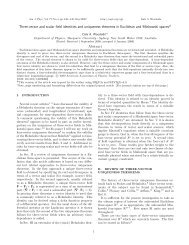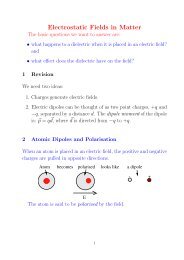<strong>Chapter</strong> 8 <strong>Vector</strong> <strong>Spaces</strong> <strong>in</strong> <strong>Quantum</strong> <strong>Mechanics</strong> 100vectors, which can be written <strong>in</strong> a different notation, (|φ〉, |ψ〉), that is more commonlyencountered <strong>in</strong> pure mathematics. But the <strong>in</strong>ner product can be viewed <strong>in</strong> another way,which leads to a new <strong>in</strong>terpretation of the expression 〈φ|ψ〉, and the <strong>in</strong>troduction of a newclass of state vectors. If we consider the equationand ‘cancel’ the |ψ〉, we get the result〈φ|ψ〉 = (|φ〉, |ψ〉) (8.67)〈φ| • = (|φ〉, •) (8.68)where the ‘•’ is <strong>in</strong>serted, temporarily, to rem<strong>in</strong>d us that <strong>in</strong> order to complete the equation,a ket vector has to be <strong>in</strong>serted. By carry<strong>in</strong>g out this procedure, we have <strong>in</strong>troduced anew quantity 〈φ| which is known as a bra or bra vector, essentially because 〈φ|ψ〉 lookslike quantities enclosed between a pair of ‘bra(c)kets’. It is a vector because, as can bereadily shown, the collection of all possible bras form a vector space. For <strong>in</strong>stance, by theproperties of the <strong>in</strong>ner product, ifthen|ψ〉 = a 1 |ϕ 1 〉 + a 2 |ϕ 2 〉 (8.69)(|ψ〉, •) = 〈ψ| • = (a 1 |ϕ 1 〉 + a 2 |ϕ 2 〉, •) (8.70)i.e., dropp<strong>in</strong>g the ‘•’ symbols, we have= a ∗ 1 (|ϕ 1〉, •) + a ∗ 2 (|ϕ 2〉, •) = a ∗ 1 〈ϕ 1| • + a ∗ 2 〈ϕ 2| • (8.71)〈ψ| = a ∗ 1 〈ϕ 1| + a ∗ 2 〈ϕ 2| (8.72)so that a l<strong>in</strong>ear comb<strong>in</strong>ation of two bras is also a bra, from which follows (after a bit morework check<strong>in</strong>g that the other requirements of a vector space are also satisfied) the resultthat the set of all bras is a vector space. Incidentally, this last calculation above shows,once aga<strong>in</strong>, that if |ψ〉 = a 1 |ϕ 1 〉 + a 2 |ϕ 2 〉 then the correspond<strong>in</strong>g bra is 〈ψ| = a ∗ 1 〈ϕ 1| + a ∗ 2 〈ϕ 2|.So, <strong>in</strong> a sense, the bra vectors are the ‘complex conjugates’ of the ket vectors.The vector space of all bra vectors is obviously closely l<strong>in</strong>ked to the vector space of allthe kets H, and is <strong>in</strong> fact usually referred to as the dual space, and represented by H ∗ . Toeach ket vector |ψ〉 belong<strong>in</strong>g to H, there is then an associated bra vector 〈ψ| belong<strong>in</strong>g tothe dual space H ∗ . However, the reverse is not necessarily true: there are bra vectors thatdo not necessarily have a correspond<strong>in</strong>g ket vector, and there<strong>in</strong> lies the difference betweenbras and kets. It turns out that the difference only matters for Hilbert spaces of <strong>in</strong>f<strong>in</strong>itedimension, <strong>in</strong> which case there can arise bra vectors whose correspond<strong>in</strong>g ket vector is of<strong>in</strong>f<strong>in</strong>ite length, i.e. has <strong>in</strong>f<strong>in</strong>ite norm, and hence cannot be normalized to unity. Such ketvectors can therefore never represent a possible physical state of a system. But these issueswill not arise here, so will not be of any concern. The po<strong>in</strong>t to be taken away from all thisis that a bra vector is not the same k<strong>in</strong>d of mathematical object as a ket vector. In fact,it has all the attributes of an operator <strong>in</strong> the sense that it acts on a ket vector to producea complex number, this complex number be<strong>in</strong>g given by the appropriate <strong>in</strong>ner product.This is <strong>in</strong> contrast to the more usual sort of operators encountered <strong>in</strong> quantum mechanicsthat act on ket vectors to produce other ket vectors. In mathematical texts a bra vectoris usually referred to as a ‘l<strong>in</strong>ear functional’. Nevertheless, <strong>in</strong> spite of the mathematical
<strong>Chapter</strong> 8 <strong>Vector</strong> <strong>Spaces</strong> <strong>in</strong> <strong>Quantum</strong> <strong>Mechanics</strong> 101dist<strong>in</strong>ction that can be made between bra and ket vectors, the correspondence between thetwo k<strong>in</strong>ds of vectors is <strong>in</strong> most circumstances so complete that a bra vector equally wellrepresents the state of a quantum system as a ket vector. Thus, we can talk of a systembe<strong>in</strong>g <strong>in</strong> the state 〈ψ|.We can summarize all this <strong>in</strong> the general case as follows: The <strong>in</strong>ner product (|ψ〉, |φ〉)def<strong>in</strong>es, for all states |ψ〉, the set of functions (or l<strong>in</strong>ear functionals) (|ψ〉, ). The l<strong>in</strong>earfunctional (|ψ〉, ) maps any ket vector |φ〉 <strong>in</strong>to the complex number given by the <strong>in</strong>nerproduct (|ψ〉, |φ〉).1. The set of all l<strong>in</strong>ear functionals (|ψ〉, ) forms a complex vector space H ∗ , the dualspace of H.2. The l<strong>in</strong>ear functional (|ψ〉, ) is written 〈ψ| and is known as a bra vector.3. To each ket vector |ψ〉 there corresponds a bra vector 〈ψ| such that if |φ 1 〉 → 〈φ 1 |and |φ 2 〉 → 〈φ 2 | thenc 1 |φ 1 〉 + c 2 |φ 2 〉 → c ∗ 1 〈φ 1| + c ∗ 2 〈φ 2|.8.6 State <strong>Spaces</strong> of Inf<strong>in</strong>ite DimensionSome examples of physical systems with state spaces of <strong>in</strong>f<strong>in</strong>ite dimension were provided<strong>in</strong> the previous Section. In these examples, we were able to proceed, at least as far asconstruct<strong>in</strong>g the state space was concerned, largely as was done <strong>in</strong> the case of f<strong>in</strong>ite dimensionalstate spaces. However, further <strong>in</strong>vestigation shows that there are features ofthe mathematics, and the correspond<strong>in</strong>g physical <strong>in</strong>terpretation <strong>in</strong> the <strong>in</strong>f<strong>in</strong>ite dimensionalcase that do not arise for systems with f<strong>in</strong>ite dimensional state spaces. Firstly, it is possibleto construct state vectors that cannot represent a state of the system and secondly, thepossibility arises of the basis states be<strong>in</strong>g cont<strong>in</strong>uously <strong>in</strong>f<strong>in</strong>ite. This latter state of affairsis not at all a rare and special case – it is just the situation needed to describe the motionof a particle <strong>in</strong> space, and hence gives rise to the wave function, and wave mechanics.8.6.1 States of Inf<strong>in</strong>ite NormTo illustrate the first of the difficulties mentioned above, consider the example of a systemof identical photons <strong>in</strong> the state |ψ〉 def<strong>in</strong>ed by Eq. (8.66). As the basis states areorthonormal we have for 〈ψ|ψ〉∞∑〈ψ|ψ〉 = |c n | 2 (8.73)If the probabilities |c n | 2 form a convergent <strong>in</strong>f<strong>in</strong>ite series, then the state |ψ〉 has a f<strong>in</strong>itenorm, i.e. it can be normalized to unity. However, if this series does not converge, then itis not possible to supply a probability <strong>in</strong>terpretation to the state vector as it is not normalizableto unity. For <strong>in</strong>stance, if c 0 = 0 and c n = 1/ √ n, n = 1, 2, . . ., then〈ψ|ψ〉 =n=0∞∑n=11n(8.74)
















